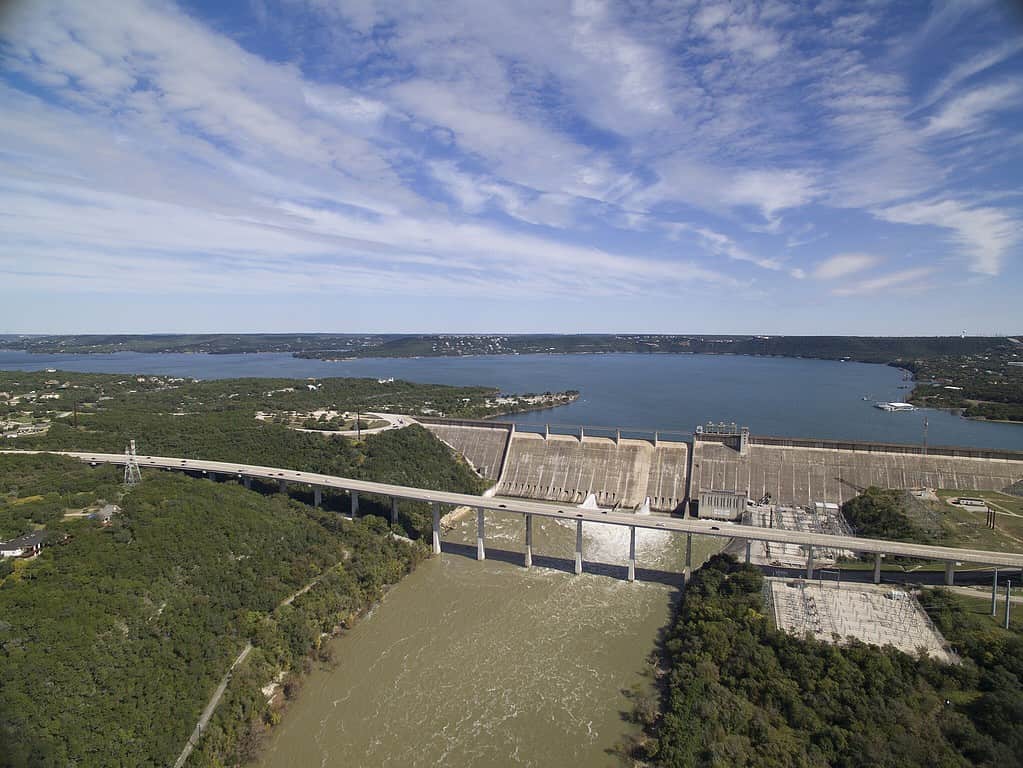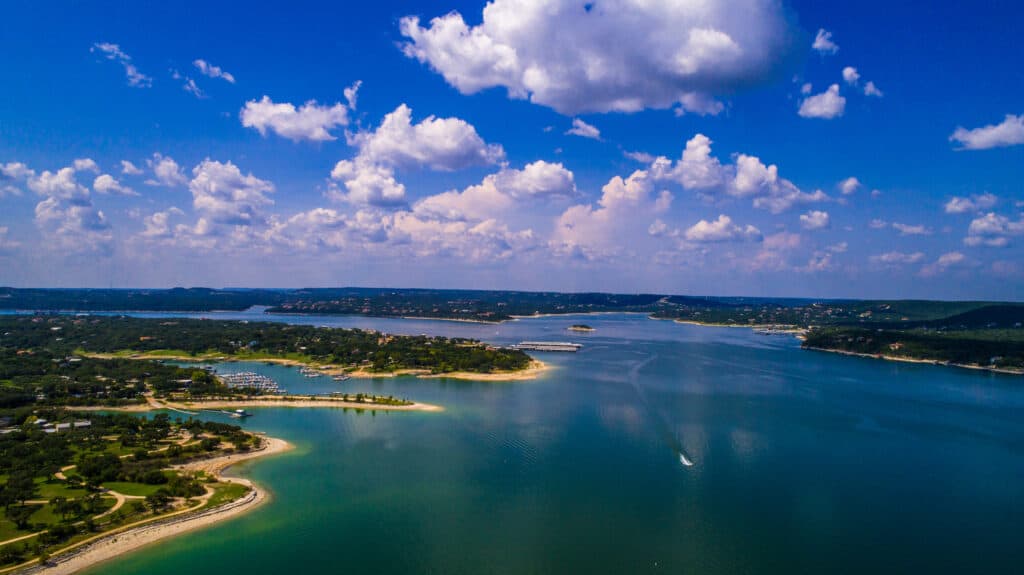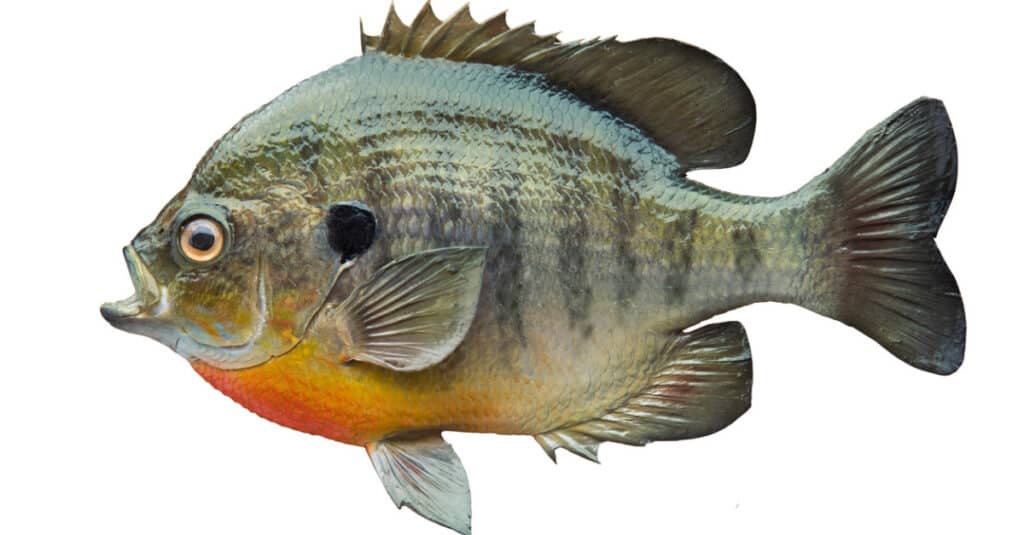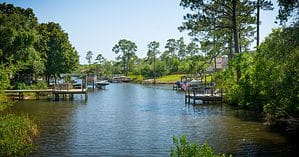Dams give us the power to direct the water where it needs to go. The water stored in reservoirs provides for the needs of surrounding cities, irrigation, and industries. Plus, dams produce electricity and protect life downstream from flooding and pollution. Many states benefit from dams, including Texas! Find out more about the benefits of the largest dam in Texas!
Where Is the Largest Dam in Texas?

The Mansfield Dam is the largest dam in Texas.
©MisterKenobi, CC BY-SA 4.0 – License
Situated in Travis county, and the canyon in Marshall Ford, the Mansfield Dam is the largest dam in Texas. Marshall Ford is an unincorporated community in which Mansfield Dam is located. Standing at 278 feet high and 7,089 feet long, this dam controls the water of the Colorado River, regulating potential flooding. And thanks to its hydroelectric generators, this dam generates 108 megawatts of power.
The reservoir behind the Mansfield Dam is called Lake Travis. Lake Travis is the only lake in the Highland Lakes chain built with the intent to hold back floodwaters. Lake Travis is at total capacity when water reaches 681 feet MSL. “MSL” stands for “mean sea level.” MSL is the elevation of the ocean measured halfway between high and low tide. The MSL is the reference point, and water capacity is measured in the number of feet above the “mean sea level.”
When Lake Travis is at 681 feet MSL, the lake holds 1.1 million acre-feet of water. But, because Lake Travis was also built to control floodwaters, it can save an additional 787,000 acre-feet of floodwaters. This is known as the “flood pool.”
Who Owns the Largest Dam in Texas?
The Lower Colorado River Authority (LCRA) owns and operates the dam. The Texas Legislature formed the LCRA as a nonprofit to manage the Mansfield Dam. Their mission is to serve the community through responsible water and energy management while also providing community service programs. Additionally, it is the LCRA’s responsibility to oversee the distribution of public power produced by the hydroelectric generators, monitor the lower Colorado River, and manage flooding.
But the LCRA does not receive money from the state; they use the revenue generated from producing and transmitting electricity from the Mansfield Dam. A minute amount of money comes from selling water.
The History of Mansfield Dam

Lake Travis is the deepest lake in Texas.
©Roschetzky Photography/Shutterstock.com
On February 19, 1937, Texas broke ground for the Mansfield Dam. At the time, the Mansfield Dam was named the Marshall Ford Dam because of the unincorporated community it resides in. However, the state renamed it the Mansfield Dam when it opened in 1941, after United States Representative J.J. Mansfield. Mansfield served in the House of Representatives for the state of Texas from 1917-1947.
The LCRA, in collaboration with the United States Bureau of Reclamation, worked on the project from 1937-1941. However, because of a devastating flood in July 1938, the LCRA increased the dam’s height to accommodate future floodwaters.
Today, Lake Travis has become a considerable resort area where visitors enjoy many outdoor activities like boating, fishing, swimming, and camping.

What Would Happen if Mansfield Dam Ever Broke?
This nightmare scenario is improbable to occur. Mansfield Dam has been operating well for over 82 years without issue. But some wonder, what if? In 2018, researchers looked into this scenario. They concluded that Central Austin would sustain widespread destruction, and thousands of people would potentially be killed. As much as 1.1 million cubic feet per second of water would pour out, with Austin getting hit by a wave traveling 50 miles per hour. The effects would devastate the communities and wildlife downriver of the dam. But, as researchers assure, this scenario has a low probability of occurring.
Wildlife Around the Mansfield Dam
Because of the Colorado River and Lake Travis, many animals call the area around Mansfield Dam home. Here is some of the fantastic wildlife around the largest dam in Texas.
Bluegill

The bluegill’s name comes from the iridescent blue coloring of its cheeks.
©iStock.com/Willard
The bluegill’s scientific name is Lepomis macrochirus, which comes from the Greek. Lepomis means “scaled gill cover,” and macrochirus means “large hand.” This is probably in reference to the bluegill’s body shape or average size. While bluegills are sunfish, one way to recognize a bluegill is its dark spot at the base of its dorsal fin. On average, the dorsal fin features about ten spines, and the anal fin sports three. Bluegills also possess small mouths and deep, flattened bodies.
Usually dark olive green in color, which lightens along the sides, bluegills have yellowish bellies. However, during the breeding season, the sides of male bluegills take on a red coloring. The bluegill’s name comes from the iridescent blue coloring of its cheeks.
Bluegills mainly feed on insects, zooplankton, worms, and snails. These fish are excellent swimmers, which makes them formidable fish, and they can change direction and swim backward simply by adjusting their fin movements. Plus, because these fish are so flat and tall, they hardly experience any water resistance, which attributes to their swimming speed.
While many enjoy these fish pan-fried, most anglers use these fish as bait to lure bigger fish. Bluegills average about 2.5 pounds as adults. However, the record for the heaviest bluegill was 4 pounds 12 ounces in 1950.
Osprey

Ospreys have excellent vision that can detect underwater objects from the air, and they catch fish by diving underwater, either foot first or by submerging their whole bodies.
©BlueBarronPhoto/Shutterstock.com
Because of the diverse fish population in Lake Travis, many ospreys hunt over its waters. Ospreys eat almost exclusively fish. Circling shallow waters, the osprey will fly 32-130 feet in the air and dive feet first to snag the fish in its razor talons. Sometimes, an osprey fully submerges in the water to grab its prey. They are very successful hunters, capturing a fish one out of every four tries.
An osprey’s lifespan is typically 15-20 years, and the oldest on record was over 25 years old. As migratory birds, ospreys average 160,000 miles of travel over their lifetime. A study observed an osprey that traveled from Massachusetts to South Africa. That osprey covered 2,700 miles in 13 days!
While ospreys migrate long distances, they return to the same spot yearly. Many ospreys use the same nests from the previous year. When the male and female ospreys return to the nest, they first renovate to prepare it for egg laying. Collecting sticks, grasses, and other vegetation, they ensure the nest is fresh and secure for the newest round of hatchlings.
Zebra Mussels

This is a bronze, two-blade propeller on a stainless steel shaft on a sailboat covered in zebra mussels.
©iStock.com/JeffCaughey
Unfortunately, zebra mussels are an invasive species affecting the entire state of Texas. So it is no surprise that they’ve also invaded the reservoir of the largest dam in Texas. The zebra mussel poses a problem for swimmers, who often cut their feet or shins on its sharp shell.
Zebra mussels most likely appeared in the Great Lakes in the 1980s. They were probably in the ballast water of cargo ships from Europe. When the vessels emptied the ballast water, the zebra mussels went with it. They quickly spread throughout the Great Lakes and maneuvered down the Mississippi River.
The problem with zebra mussels is how they affect the native ecosystems. They filter out algae other species need to survive and attach to native mussels and smother them. Zebra mussels can clog pipes, damage water intakes, and obstruct power stations. Removing them takes time and effort.
That is why it is illegal in the state of Texas to be in possession of or transport zebra mussels.
Where is The Mansfield Dam Located on a Map?
Tucked away 13 miles northwest of Austin, Texas, Mansfield Dam is a dam constructed across a canyon at Marshall Ford on the Colorado River.
Here is The Mansfield Dam on a map:
In Conclusion
The largest dam in Texas provides many resources, such as electricity and water reserves, and it also plays a crucial role in controlling water levels and preventing flooding. All in all, this 278-Foot behemoth is a feature you won’t want to miss in Texas.
The photo featured at the top of this post is © MisterKenobi, CC BY-SA 4.0 – License / Original
Thank you for reading! Have some feedback for us? Contact the AZ Animals editorial team.







